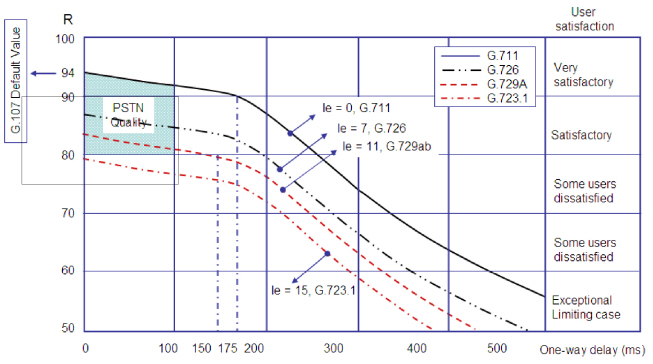Speech Compression Impairment
Choice of vocoder affects Ie value (effective equipment impairment).The E-model measures and quantifies the perceived quality of different codecs. Ie factors of different speech compression algorithms are shown in Table 3 Speech compression impairment factor Ie on page 20 . Other impairment values such as packer loss or echo are not included
| Codec |
Reference |
Bit rate |
Ie value |
|---|---|---|---|
| SB-ADPCM |
G.722 |
64 |
-1 |
| ADPCM |
G.726 |
32 |
7 |
| CS-ACELP |
G.729 A(AB) |
8 |
11 |
| MP-MLQ |
G.723.1 |
6.3 |
15 |
G.722 is an ITU-T standard 7 kHz wideband speech codec operating at 48, 56 and 64 kbit/s. and supported by MX-ONE IP phones. MX-ONE IP phones are operating at 64 kb/s rate as it provides the best speech quality.
The Ie value shown for G.722 in Table 3 is retrieved from the equation, Ie, wb = Ie + 15 where Ie, wb is effective equipment impairment factor defined for wideband codec. Ie, wb value varies depending on actual bandwidth utilized by G.722 codec as shown below.
| G.722 (64) |
Ie,wb = 14 |
Ie = -1 |
|
| G.722 (56) |
Ie,wb = 18 |
Ie = 3 |
|
| G.722 (48) |
Ie,wb = 24 |
Ie = 9 |
G.729A is an extension of G.729 (and compatible), but requires less computational power with marginally reduced speech quality (Ie value 10 for G.729 vs. 11 for G.729A). Another G.729 extension of annex B provides a silence compression method that enables a voice activity detection (VAD) module. Only the term G.729A is used in this planning section but G.729A and G.729AB have the same impairment value (Ie = 11)
Figure 7: Speech compression impairment with one-way delay on page 21 illustrates impairment characteristics of speech compression with regard to one-way delay but in the absence of any other impairment factors. The comparison shows four popular IP codecs, G.711, G.729A, G.723.1 (MP-MLQ, 6.3 kbit/s) and G.726 (ADPCM).
G.711 codec has Ie = 0 at no delay and set to R = 94 as default in G.107. G.722 (64) will be slightly better than G.711 (not shown). G.726 starts at 87, G.729A at 83 (Ie = 11) and G.723.1 at 79 (Ie = 15) with zero one-way delay.
As also shown in table 3, G.723.1 has larger Ie values (more quality degradation) and, therefore, has smaller tolerance against delay impairment for a given voice quality level (e.g. R=70). For this reason, G.723.1 is not recommended and even excluded in capability negotiation in MX-ONE IP-Telephony application.
The shaded region marked "PSTN quality" represents the traditional wireline PSTN and is bounded by the best G.711 performance on the top, R = 80 on the bottom and delay between 0 and 100 ms.

Impact of transcoding
Transcoding is defined as two or more encodings of different types of non-G.711 codecs, separated by G.711. For instance, a connection between two DECT potable terminals requires G.726 to G.711 to G.726 transcoding. Even worse, DECT terminal to an IP phone using G.729A codec requires G.726 to G.711 to G.729A transcoding through MX-ONE media gateway.
According to E-Modeling Rule, Ie-values of speech compression impairment are additive.
For instance, G.726 to G.711 to G.729A results in;
Ie total = G.726 (Ie = 7) to G.711 (Ie = 0) to G.729A (Ie = 11) = 5 + 11 = 16.
The voice quality degradation due to transcoding is much more complicated issue but this example demonstrates that the i.e factor is severely affected due to transcoding. Generally speaking, only one transcoding can be tolerated before the performance drops below acceptable levels, for most combinations of non-G.711 codecs.
It is important to reduce this additive
impairment by considering Transcoder Free Operation (TFO)
or
at least keep minimum steps of transcoding by eliminating unnecessary
conversion(s).